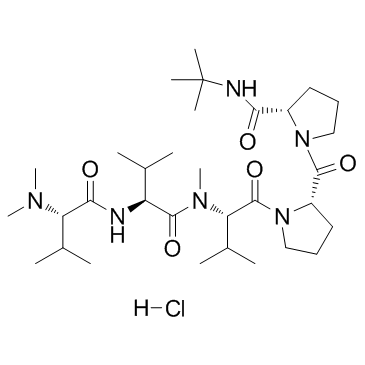| Description |
Tasidotin hydrochloride is a peptide analog of the antimitotic depsipeptide dolastatin 15, as an inhibitor of microtubule assembly and microtubule dynamics.
|
| Related Catalog |
|
| Target |
Microtubule[1]
|
| In Vitro |
Compared with other breast carcinoma lines, relatively low amounts of Tasidotin enters NCI/ADR-RES cells, consistent with Tasidotin's also being a P-glycoprotein substrate. Of the remaining lines, the greatest difference in sensitivity to Tasidotin is between the more sensitive MDA-MB-435 line and the less sensitive HS 578-T line. The IC50 values in the two lines are 4 and 200 nM, respectively[1]. The IC50 in Ewing's sarcoma, rhabdomyosarcoma, osteosarcoma, and synovial sarcoma lines ranges from 2 to 320 nM. In the SK-ES1 and RH30 cell lines, Tasidotin induces a G2-M arrest that persists for 48 h after Tasidotin is washed from the cells. In vitro, more than half the cells are in the early or late phase of apoptosis 48 h after treatment with Tasidotin. Following treatment for 24 h with 160 nM Tasidotin, the RH30 line and SK-ES1 line each shows an accumulation of cells in the G2-M phase. At hour 24, nearly all the RH30 cells are in the G2-M phase[2].
|
| In Vivo |
In vivo, a significant increase in apoptotic nuclei is apparent in xenograft tumors harvested within 24 h after a 5-day course of Tasidotin. Mice treated with 100 mg/kg have a mean weight loss of >20% with no return to their baseline starting weight, and one mouse dies before the second treatment course. The mice treated with 90 mg/kg/d Tasidotin have a mean weight loss of <16% following each 5-day treatment of Tasidotin[2].
|
| Kinase Assay |
MDA-MB-435 and HS 578-T breast carcinoma cells are grown in 25 mL of medium in Corning 75-cm2 culture flasks. For monolayer cells, when the cells are at near confluence, the medium is exchanged for 15 mL of fresh medium containing the indicated concentration of 0.1 μM [3H]Tasidotin, and the incubation continues for the indicated time. Monolayer cells are harvested by scraping them from the surface of the culture flask. For suspension cells, when the cells are in log phase and at approximately 106 cells/mL, the [3H]Tasidotin is added at the indicated concentration, and the incubation continued for the indicated time as specified in individual experiments. Suspension cells are harvested by centrifugation. Both types of cells are washed twice with PBS, pH 7.2. The cells are resuspended in 0.5 mL of water and disrupted by 10 s periods of sonication at 28 W, followed by 10 s pauses, for a total of 1 min. Protein content and radiolabel of all cell extracts are determined[1].
|
| Cell Assay |
Growth inhibition is determined by the microculture tetrazolium method. Briefly, cells are seeded in 96 well flat-bottomed microtiter plates at a density of 500 cells per well in 100 μL of medium. After overnight incubation, 100 μL of medium containing Tasidotin are added to achieve specified final concentrations and a final volume of 200 μL/well. At 120 h, the relative metabolic activities of treated and untreated cells are measured by mitochondrial conversion of MTT to formazine. At the completion of the drug treatment, 250 μg of MTT are added to each well and incubated at 37°C, 5% CO2 for 6 h. Formazine crystals are dissolved in DMSO and absorbance at 595 nm is measured on a VERSAmax spectrophotometer. Absorbance values are normalized to the values obtained for the vehicle-treated cells to determine the percentage of survival. The IC50 is defined as the concentration at which absorbance of the treated cells is 50% that of the controls[2].
|
| Animal Admin |
Mice[2] CB17 female scid-/- mice are treated with Tasidotin daily for 5 days via i.p. injection starting on day 1 every 21 days for two cycles. Five non–tumor-bearing mice are assigned to each treatment group. Mice are treated with either 70, 80, 90, or 100 mg/kg/d Tasidotin. A toxic event is defined as weight loss ≥20% of the animal's weight at the time of randomization or death. The maximally tolerated dose (MTD) is defined as the highest dose at which no toxicity occurred.
|
| References |
[1]. Bai R, et al. Intracellular activation and deactivation of Tasidotin, an analog of dolastatin 15: correlation with cytotoxicity. Mol Pharmacol. 2009 Jan;75(1):218-26. [2]. Garg V, et al. Preclinical analysis of Tasidotin HCl in Ewing's sarcoma, rhabdomyosarcoma, synovial sarcoma, and osteosarcoma. Clin Cancer Res. 2007 Sep 15;13(18 Pt 1):5446-54.
|
